电子科技大学:《语言学通论 General Linguistics》课程教学资源(课件讲稿)01 Introduction(主讲:楚军)
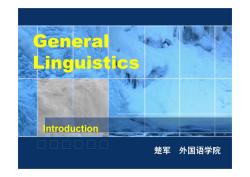
General Linguistics ntroduction 楚军外国语学院
Introduction 楚军 外国语学院 General Linguistics
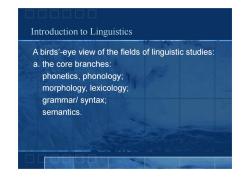
Introduction to Linguistics A birds'-eye view of the fields of linguistic studies: a.the core branches: phonetics,phonology; morphology,lexicology; grammar/syntax; semantics
Introduction to Linguistics A birds’-eye view of the fields of linguistic studies: a. the core branches: phonetics, phonology; morphology, lexicology; grammar/ syntax; semantics
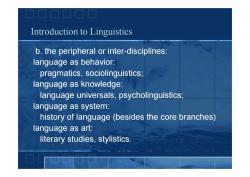
Introduction to Linguistics b.the peripheral or inter-disciplines: language as behavior: pragmatics,sociolinguistics; language as knowledge: language universals,psycholinguistics; language as system: history of language(besides the core branches) language as art: literary studies,stylistics
Introduction to Linguistics b. the peripheral or inter-disciplines: language as behavior: pragmatics, sociolinguistics; language as knowledge: language universals, psycholinguistics; language as system: history of language (besides the core branches) language as art: literary studies, stylistics
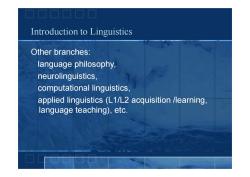
Introduction to Linguistics Other branches: language philosophy, neurolinguistics, computational linguistics applied linguistics (L1/L2 acquisition /learning language teaching),etc
Introduction to Linguistics Other branches: language philosophy, neurolinguistics, computational linguistics, applied linguistics (L1/L2 acquisition /learning, language teaching), etc
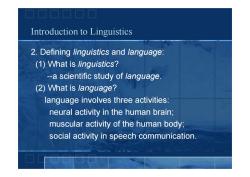
Introduction to Linguistics 2.Defining linguistics and language: (1)What is linguistics? --a scientific study of language. (2)What is language? language involves three activities: neural activity in the human brain; muscular activity of the human body; social activity in speech communication
Introduction to Linguistics 2. Defining linguistics and language: (1) What is linguistics? --a scientific study of language. (2) What is language? language involves three activities: neural activity in the human brain; muscular activity of the human body; social activity in speech communication

Introduction to Linguistics Language is a means of verbal communication. Language is:(p.3) rule-governed, instrumental, social and conventional(Social Semiotic)
Introduction to Linguistics Language is a means of verbal communication. Language is: (p.3) rule-governed, instrumental, social and conventional (Social Semiotic)

Design features of language (3)What are the design features of language? a.arbitrariness:signifier signified Two schools about the relationship between the signifier (sound image)and the signified (concept/referent): The naturalists:(Plato) There exists an intrinsic correspondence (a natural connection)between the sound image and the concept/referent
Design features of language (3) What are the design features of language? a. arbitrariness: signifier & signified Two schools about the relationship between the signifier (sound image) and the signified (concept/referent): The naturalists: (Plato) There exists an intrinsic correspondence (a natural connection) between the sound image and the concept/referent
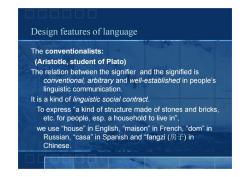
Design features of language The conventionalists: (Aristotle,student of Plato) The relation between the signifier and the signified is conventional,arbitrary and well-established in people's linguistic communication. It is a kind of linguistic social contract. To express "a kind of structure made of stones and bricks, etc.for people,esp.a household to live in", we use“house”in English,"maison"”in French,“dom”in Russian,“casa”in Spanish and"fangzi(房子)in Chinese
Design features of language The conventionalists: (Aristotle, student of Plato) The relation between the signifier and the signified is conventional, arbitrary and well-established in people’s linguistic communication. It is a kind of linguistic social contract. To express “a kind of structure made of stones and bricks, etc. for people, esp. a household to live in”, we use “house” in English, “maison” in French, “dom” in Russian, “casa” in Spanish and “fangzi (房子) in Chinese
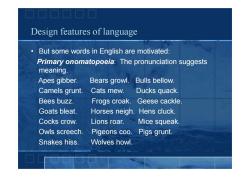
Design features of language But some words in English are motivated: Primary onomatopoeia:The pronunciation suggests meaning. Apes gibber. Bears growl.Bulls bellow. Camels grunt. Cats mew. Ducks quack. Bees buzz. Frogs croak.Geese cackle Goats bleat. Horses neigh.Hens cluck. Cocks crow. Lions roar. Mice squeak. Owls screech. Pigeons coo.Pigs grunt. Snakes hiss. Wolves howl
Design features of language • But some words in English are motivated: Primary onomatopoeia: The pronunciation suggests meaning. Apes gibber. Bears growl. Bulls bellow. Camels grunt. Cats mew. Ducks quack. Bees buzz. Frogs croak. Geese cackle. Goats bleat. Horses neigh. Hens cluck. Cocks crow. Lions roar. Mice squeak. Owls screech. Pigeons coo. Pigs grunt. Snakes hiss. Wolves howl
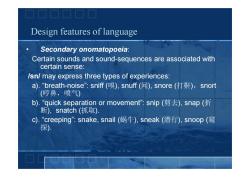
Design features of language Secondary onomatopoeia: Certain sounds and sound-sequences are associated with certain sense: /sn/may express three types of experiences: a).“"breath-noise”:snif(嗅),snuf(闻),snore(打鼾),snort (哼鼻,喷气) b).“quick separation or movement":snip(剪去),snap(折 断),snatch(抓取). c).“creeping'':snake,snail(蜗牛),sneak(潜行),snoop(窥 探)
Design features of language • Secondary onomatopoeia: Certain sounds and sound-sequences are associated with certain sense: /sn/ may express three types of experiences: a). “breath-noise”: sniff (嗅), snuff (闻), snore (打鼾),snort (哼鼻,喷气) b). “quick separation or movement”: snip (剪去), snap (折 断), snatch (抓取). c). “creeping”: snake, snail (蜗牛), sneak (潜行), snoop (窥 探)
按次数下载不扣除下载券;
注册用户24小时内重复下载只扣除一次;
顺序:VIP每日次数-->可用次数-->下载券;
- 山东省“成人教育特色课程”项目配套教材:《大学语文》课程教材电子版(主编:戴永新).pdf
- 聊城大学:《大学语文》课程教学资源(阅读文献)中国现当代文学经典作品选.pdf
- 聊城大学:《大学语文》课程教学资源(阅读文献)外国文学经典作品选.pdf
- 聊城大学:《大学语文》课程教学资源(阅读文献)中国古代文学经典作品选.pdf
- 聊城大学:《大学语文》课程教学资源(电子教案讲义,共十五讲).docx
- 运城学院:《文学概论 literature theory》课程教学资源(电子教案,打印版,2/2,共两编八章).pdf
- 运城学院:《文学概论 literature theory》课程教学资源(电子教案,打印版,1/2,共三篇八章).pdf
- 运城学院:《文学概论 literature theory》课程教学资源(教学大纲,打印版).pdf
- 运城学院:《秘书写作 Daily practical Writing》课程PPT教学课件(事务文书写作)15.总结述职报告.ppt
- 运城学院:《秘书写作 Daily practical Writing》课程PPT教学课件(事务文书写作)14.讣告悼词.ppt
- 运城学院:《秘书写作 Daily practical Writing》课程PPT教学课件(事务文书写作)13.欢迎欢送答谢表扬邀请信.ppt
- 运城学院:《秘书写作 Daily practical Writing》课程PPT教学课件(事务文书写作)12.聘书.ppt
- 运城学院:《秘书写作 Daily practical Writing》课程PPT教学课件(事务文书写作)11.请柬.ppt
- 运城学院:《秘书写作 Daily practical Writing》课程PPT教学课件(事务文书写作)10.求职信简历.ppt
- 运城学院:《秘书写作 Daily practical Writing》课程PPT教学课件(事务文书写作)09.倡议书建议书.ppt
- 运城学院:《秘书写作 Daily practical Writing》课程PPT教学课件(事务文书写作)08.启事.ppt
- 运城学院:《秘书写作 Daily practical Writing》课程PPT教学课件(事务文书写作)07.证明信.ppt
- 运城学院:《秘书写作 Daily practical Writing》课程PPT教学课件(事务文书写作)06.申请书.ppt
- 运城学院:《秘书写作 Daily practical Writing》课程PPT教学课件(事务文书写作)05.开幕词、闭幕词.ppt
- 运城学院:《秘书写作 Daily practical Writing》课程PPT教学课件(事务文书写作)04.演讲稿写作训练.ppt
- 电子科技大学:《语言学通论 General Linguistics》课程教学资源(课件讲稿)02 句法 Syntax.pdf
- 电子科技大学:《语言学通论 General Linguistics》课程教学资源(课件讲稿)03 Formalist Approach.pdf
- 电子科技大学:《语言学通论 General Linguistics》课程教学资源(课件讲稿)04 Formalist Approach.pdf
- 电子科技大学:《语言学通论 General Linguistics》课程教学资源(课件讲稿)05 句法 Syntax.pdf
- 电子科技大学:《语言学通论 General Linguistics》课程教学资源(课件讲稿)06 Functional Grammar.pdf
- 电子科技大学:《语言学通论 General Linguistics》课程教学资源(课件讲稿)07 Semantics(Introduction).pdf
- 电子科技大学:《语言学通论 General Linguistics》课程教学资源(课件讲稿)语义学——Types of word-meaning.pdf
- 电子科技大学:《语言学通论 General Linguistics》课程教学资源(课件讲稿)语义学——Semantics(Sense Relations).pdf
- 电子科技大学:《语言学通论 General Linguistics》课程教学资源(课件讲稿)语义学——Context, changes in word meaning, figures of speech.pdf
- 电子科技大学:《语言学通论 General Linguistics》课程教学资源(课件讲稿)语义学——Componential Analysis.pdf
- 电子科技大学:《语言学通论 General Linguistics》课程教学资源(课件讲稿)语义学——Sentence meaning(Predication Analysis).pdf
- 电子科技大学:《语言学通论 General Linguistics》课程教学资源(课件讲稿)10 Langugae, culture & society.pdf
- 电子科技大学:《语言学通论 General Linguistics》课程教学资源(课件讲稿)09 Pragmatics(Utterance Meaning).pdf
- 电子科技大学:《语言学通论 General Linguistics》课程教学资源(课件讲稿)形态学 Morphology.pdf
- 电子科技大学:《语言学通论 General Linguistics》课程教学资源(课件讲稿)认知语言学中的相关话题 Cognitive Linguistics.pdf
- 弟子规(全文).pdf
- 《中国语言文化 Chinese Language and Culture》课程教学资源(书籍阅读材料)《中国古典哲学名著选读》郭齐勇.pdf
- 《中国语言文化 Chinese Language and Culture》课程教学资源(书籍阅读材料)《唐诗三百首》中英文对照(许渊冲)300 Tang Poems(Classified by Theme).pdf
- 《中国语言文化 Chinese Language and Culture》课程教学资源(书籍阅读材料)《二十四诗品校注译评》祖保泉.pdf
- 《中国语言文化 Chinese Language and Culture》课程教学资源(书籍阅读材料)《近代中国之种族观念》刘东.pdf
